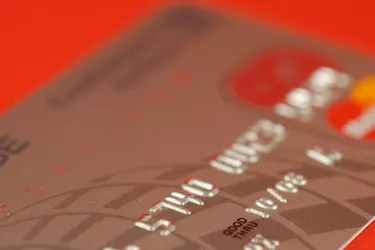
Using a ATM can make banking faster and more efficient by permitting consumers to complete relatively simple financial transactions using the automated teller machine rather than waiting in line inside the bank to conduct business with a banking professional. Consumers can withdraw cash from their bank accounts, transfer funds from one account to another -- for example, from a savings account into a personal checking account -- or check bank balances. You may also deposit funds, including cash and checks, by going to an ATM. These machines rely on your card to identify banking accounts to ensure safe, accurate transactions, but it's possible to go to an ATM without having your credit card handy.
ATM
Video of the Day
Consumers use credit cards or debit cards to access cash from an ATM. Typically, you will approach an ATM and look for a graphic design indicating which direction the card should be inserted or swiped. After the machine reads your credit card or debit card, you'll be prompted to punch in your secret PIN code using the ATM's physical keypad or the ATM touch-screen keypad. Once you've successfully entered the PIN code, the ATM will ask you to choose from a menu of options, including withdrawing money, depositing funds or transferring money to another account. If you're withdrawing money, you'll be prompted to specify what amount of money to remove from your bank account. To conclude, the ATM will ask whether you'd like a receipt to document the transaction. Depending on the style of machine, your credit card or debit card may be ejected at that point.
Video of the Day
Credit Cards
You can use credit cards to access funds at an ATM, but it's not absolutely necessary. Cash withdrawals from ATM made with credit cards act somewhat differently than cash withdrawals made with debit cards. When you go to an ATM with your credit card to make a withdrawal, chances are that you're not withdrawing existing funds from your bank account balance. Instead, you're asking the ATM for a cash advance. The ATM machine will still dispense the amount of money that you're requesting, but this will result in a charge to your credit card account rather than a deduction from your bank balance. Credit card companies will typically assess consumers a special fee and interest rate for cash advances that can be higher than interest rates for traditional purchases. If you're visiting an ATM that's not associated with the bank issuing your credit card, expect to pay additional fees. You can still go to an ATM without your credit card if you have a debit card.
Debit Cards
When possible, use a debit card rather than a credit card to go to an ATM to avoid cash advance fees and special interest rates. Withdrawing money from your bank account at an ATM by using your debit card doesn't necessarily create additional charges, unless you're using an ATM not associated with the bank where your personal checking account or savings account it held.
Future Developments
While ATMs still require the use of a credit card or debit card to access funds, future developments may veer away from this requirement. Technological advancements may soon permit consumers to transfer funds by punching in a 10-digit cell phone number linked to virtual accounts, according to Bank Systems Technology.